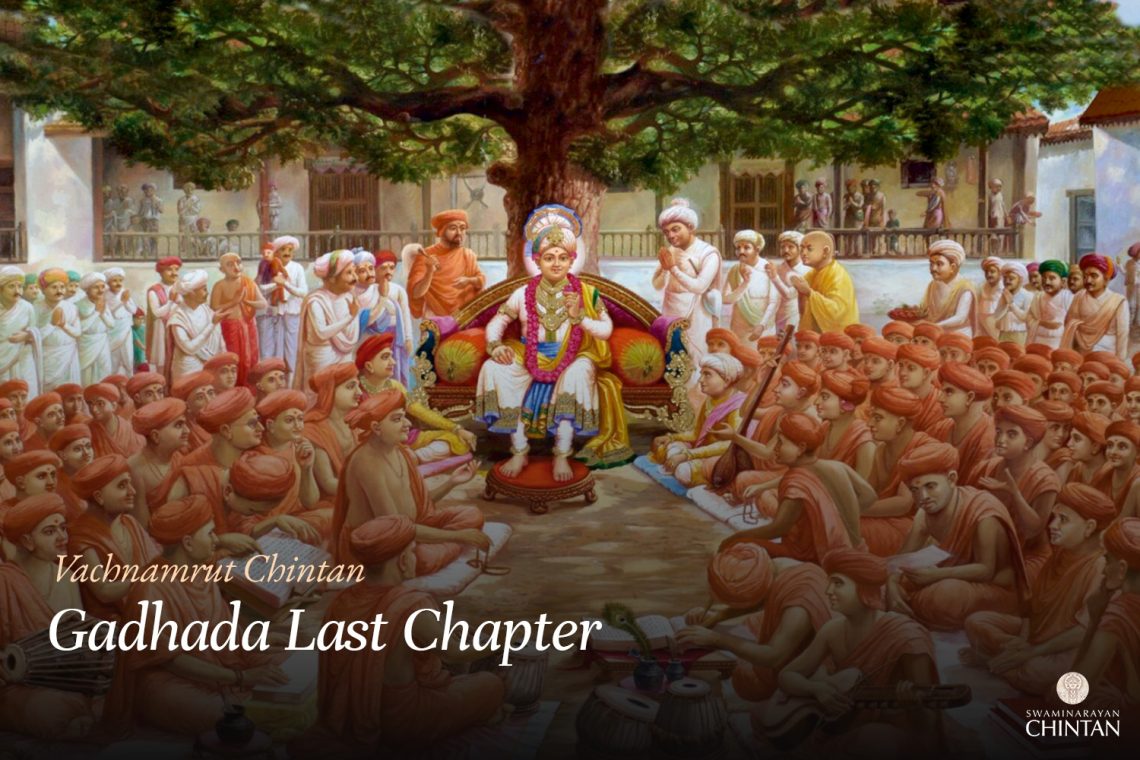Central Insights:
- The Wax-Coated Thread, Equivalence of Dharma and Bhakti
Subject Addressed:
- The purpose of Bhagwan’s incarnation and Ekantik Dharma (holistic spiritual practice).
Key Points:
- Bhagwan incarnates to establish the Bhagwat Dharma (path of devotion) practiced by His Ekantik Bhaktas (holistic devotees).
- Those without complete surrender to Bhagwan’s devotees are certain to falter in their Satsang (holy fellowship).
Explanation:
In this Vachanamrut, with the inspiration of Maharaj, Shukmuni Swami posed a question to Gopalanand Swami. The question centered on how Bhakti (devotion) enables a soul to transcend Maya (illusory power of God) and attain Akshardham (divine abode of God), while Dharma (moral integrity) allows one to reach Devalok (celestial realms) temporarily, only to return to the mortal world when good deeds are exhausted. It was also observed that Bhagwan’s incarnations are for the purpose of establishing Dharma धर्मसंंस्थापनार्थाय सम्भवामि युगे-युगे —dharmasaṁ sthāpanārthāya sambhavāmi yuge yuge, as stated in the Gita) and not for Bhakti. Therefore, how is Dharma considered greater than Bhakti, to the extent that Bhagwan incarnates for its establishment?
Gopalanand Swami attempted to provide an answer but could not satisfactorily establish Dharma as superior to Bhakti.
Maharaj then explained: Dharma can be categorized into two types—Nivritti Dharma (path of renunciation) and Pravritti Dharma (path of worldly activity). Both types can exist with or without a relationship to Bhagwan. Maharaj emphasized that Bhagwat Dharma—practiced by sages like Shuk, Sanakadik, Dhruv, Prahlad, and Ambrish—is inseparable from Bhakti. Bhagwat Dharma and Bhakti are one and the same.
The purpose of Bhagwan’s incarnation, as stated in the Gita परित्राणाय साधूनाम् — paritrāṇāya sādhūnām and the Bhagavatam परामहँँसानांं मुनीनाममलात्मनाम् भक्तियोग विधानार्थम् — paramahaṁ sānāṁ munīnām amalātmanām bhaktiyoga vidhānārtham, is to establish this Bhagwat Dharma. His incarnation is not solely for the promotion of Varnashram Dharma (conduct based on caste and stage of life) but for demonstrating and establishing the Dharma of His Bhagwat Paramhansas (supreme renunciates devoted to God). In essence, Bhagwan incarnates to propagate Ekantik Dharma, which inherently includes Bhakti as its highest form. Maharaj also affirmed that His own purpose is to promote Ekantik Bhakti and declared that He has no attachment beyond Bhagwan and His devotees.
Maharaj elaborated on His personal nature, likening it to that of sages such as Shuk, Jadbharat, Dattatreya, and Rushabhdev, who naturally prefer solitary, serene locations like forests or mountains. Despite His personal preference for isolation, Maharaj resides amidst the multitude solely for the sake of His devotees. He draws a parallel between His actions and Bhagwan leaving His divine abode to descend into the sorrowful material world purely out of love for His devotees. Even amidst the crowd, Maharaj remains internally unbound and considers all activities done for the sake of devotees as Nivritti (renunciation) and a means to liberation.
Maharaj further explained that the minor faults of Bhagwan’s devotees are not a cause of concern for Him. He considers efforts made for devotees as acts of supreme Bhakti and equates them with inaction, free from worldly attachment. If such faults exist in oneself, they should be rectified, but the flaws of others should not be criticized unless they involve a significant violation of sacred vows. Winning debates against devotees and taking pleasure in their defeat is considered a grave sin, worse than committing the Panch Mahapap (five great sins). Instead, one should rejoice in being defeated by a devotee and honor them with heartfelt respect.
Maharaj stated: “I have no attachment to those who criticize Bhagwan’s devotees. Even if they are relatives, I cannot relish food or water offered by them. My love for devotees is not based on physical relations but on the spiritual essence. Anyone without devotion in Satsang will eventually expose their true nature, either by selfish motives or deceitful behavior, and falter in their path like a wax-coated thread that stiffens during winter but loosens in summer.”
The analogy of the wax-coated thread was elaborated further. Maharaj explained that such devotion, lacking firm determination,
remains intact only as long as respect and benefits are received within the Satsang. When faced with insults or hardships, such individuals lose their resolve, exposing their lack of genuine surrender and commitment to Satsang.
Concluding the discourse, Maharaj expressed that He considers only those Satsangis with unwavering determination and dedication, even in the face of adversity, as truly dear to Him. He added that His ultimate purpose, in both this world and the divine abode, is to remain among such devotees. Maharaj advised His devotees to develop the same firm resolve and not maintain attachment to the body or its relations. He affirmed, “A true friend is one who tells you what is beneficial for you, even at the risk of displeasing you.”
Glossary
| Ekantik Dharma – Single- minded, holistic devotion A combination of dharma, gyan (knowledge), vairagya (detachment), and bhakti (devotion), leading to liberation. |
| Bhakti – Devotion Loving and selfless worship of God. |
| Nivritti Dharma – Path of renunciation |
| Pravritti Dharma – Path of worldly activity |
| Paramhansa – Supreme Renunciates A highly evolved saint who has renounced all worldly attachments and is solely devoted to God. |
| Shukmuni Swami – A great saint of Bhagwan Swaminarayan |
| Akshardham – The eternal supreme abode of Bhagwan Swaminarayan The divine realm where Bhagwan Swaminarayan resides along with Akshar Muktas (Divine Liberated Souls) |
| Varnashram Dharma – Duties based on one’s caste and stage of life The societal structure defining responsibilities according to one’s role in life, primarily on the path of action. |

